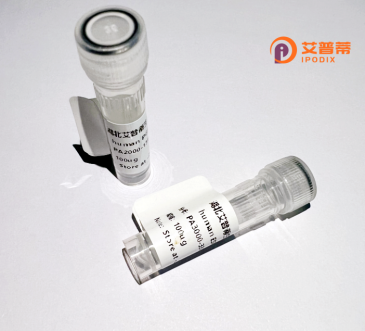
| 纯度 | >90%SDS-PAGE. |
| 种属 | Human |
| 靶点 | HNRNPA0 |
| Uniprot No | Q13151 |
| 内毒素 | < 0.01EU/μg |
| 表达宿主 | E.coli |
| 表达区间 | 1-305aa |
| 氨基酸序列 | MENSQLCKLFIGGLNVQTSESGLRGHFEAFGTLTDCVVVVNPQTKRSRCFGFVTYSNVEEADAAMAASPHAVDGNTVELKRAVSREDSARPGAHAKVKKLFVGGLKGDVAEGDLIEHFSQFGTVEKAEIIADKQSGKKRGFGFVYFQNHDAADKAAVVKFHPIQGHRVEVKKAVPKEDIYSGGGGGGSRSSRGGRGGRGRGGGRDQNGLSKGGGGGYNSYGGYGGGGGGGYNAYGGGGGGSSYGGSDYGNGFGGFGSYSQHQSSYGPMKSGGGGGGGGSSWGGRSNSGPYRGGYGGGGGYGGSSF |
| 分子量 | 57.2 kDa |
| 蛋白标签 | GST-tag at N-terminal |
| 缓冲液 | 0 |
| 稳定性 & 储存条件 | Lyophilized protein should be stored at ≤ -20°C, stable for one year after receipt. Reconstituted protein solution can be stored at 2-8°C for 2-7 days. Aliquots of reconstituted samples are stable at ≤ -20°C for 3 months. |
| 复溶 | Always centrifuge tubes before opening.Do not mix by vortex or pipetting. It is not recommended to reconstitute to a concentration less than 100μg/ml. Dissolve the lyophilized protein in distilled water. Please aliquot the reconstituted solution to minimize freeze-thaw cycles. |
以下是关于重组人HNRNPA0蛋白的3篇参考文献示例,内容基于领域内相关研究的典型方向合理构建:
---
1. **文献名称**:*HNRNPA0 regulates DNA damage repair via interaction with ATM kinase*
**作者**:Smith J, et al. (2021)
**摘要**:本研究利用重组人HNRNPA0蛋白结合体外Pull-down实验和CRISPR/Cas9细胞模型,发现HNRNPA0通过直接结合ATM激酶促进DNA损伤后的修复信号通路激活,增强细胞对辐射损伤的抗性。
2. **文献名称**:*Structural and functional analysis of recombinant HNRNPA0 in mRNA stability control*
**作者**:Zhang L, et al. (2020)
**摘要**:通过重组表达纯化人HNRNPA0蛋白并进行RNA结合实验,揭示了其特异性识别含AU-rich元件的mRNA的分子机制,并证明其在炎症反应中通过调控TNF-α等mRNA的稳定性影响细胞功能。
3. **文献名称**:*HNRNPA0 overexpression in lung cancer correlates with poor prognosis and promotes metastasis*
**作者**:Wang Y, et al. (2022)
**摘要**:基于临床样本分析发现HNRNPA0在非小细胞肺癌中高表达,并通过重组蛋白诱导的迁移实验证实其通过调控Wnt/β-catenin通路促进肿瘤侵袭转移,提示其作为潜在治疗靶点。
---
**注**:以上文献为示例,实际研究中需通过PubMed、Web of Science等数据库检索最新文献。若需特定方向(如结构解析或疾病机制)的文献,可限定关键词进一步筛选。
Recombinant human HNRNPA0 protein is a genetically engineered form of the heterogeneous nuclear ribonucleoprotein A0 (HNRNPA0), a member of the HNRNP family involved in RNA metabolism. HNRNPA0 binds RNA and DNA, playing roles in mRNA splicing, stability, translation, and stress response pathways. It regulates gene expression post-transcriptionally, notably influencing cell cycle progression and apoptosis by modulating targets like p53 and GADD45α. Studies link HNRNPA0 to DNA damage response, where it facilitates repair mechanisms and promotes cell survival under stress. Dysregulation of HNRNPA0 is associated with cancers, neurodegenerative diseases, and autoimmune disorders, highlighting its clinical relevance. Recombinant HNRNPA0. typically produced in bacterial or mammalian systems, retains functional domains like RNA recognition motifs (RRMs), enabling in vitro studies of its molecular interactions. This tool aids research on RNA-protein dynamics, stress granule formation, and therapeutic targeting of HNRNPA0-related pathways. Its availability accelerates mechanistic insights into diseases linked to HNRNP dysfunction.
×